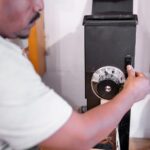Imagine stepping into a warm shower only to be interrupted by a stubborn error message on your tankless water heater. The frustration is real, but understanding these messages can be your key to uninterrupted comfort. Tankless water heaters, while efficient and space-saving, can manifest issues that might seem cryptic at first glance. Understanding these error messages is not just about convenience—it’s vital for maintaining your system’s longevity and performance.
- Explore the most common error messages and how to interpret them to keep your tankless water heater in peak condition.
- Uncover the mystery behind Error Code E1, including potential causes and simple, practical solutions you can apply yourself.
- Dive into advanced troubleshooting techniques for resolving complex issues, arming you with the necessary skills and tools.
By delving into these insights, you’ll not only enhance the efficiency of your tankless water heater but also gain a clearer understanding, empowering you to manage and prevent future issues with ease.
Decoding Common Tankless Water Heater Error Messages: Quick Diagnostic Solutions
Encountering error messages on your tankless water heater can seem daunting, but they often provide crucial information to pinpoint the problem. Understanding these messages is key to diagnosing issues quickly and efficiently, ensuring your system remains in optimal working condition.
Most tankless water heaters have built-in systems to display common error messages, alerting users of issues ranging from simple to complex. These messages typically relate to problems such as insufficient hot water, ignition failures, or ventilation troubles. Interpreting these codes can help you identify whether the issue involves the ignition system, water flow, or temperature sensors.
Begin by closely examining your water heater’s manual, which often includes a list of error codes and their meanings. Understanding this context is essential for proper diagnostic solutions. After identifying the error code, basic checks such as verifying power supplies, gas lines, and water inlet screens can often resolve the problem.
Simple solutions, like cleaning air filters or resetting the unit, can address many common issues. Additionally, checking for blockages or loose connections can be a critical step in the diagnostic process. These steps not only restore proper operation but also improve the overall energy efficiency of your tankless water heater.
Understanding Error Code E1: Causes and Fixes
Error Code E1 is one of the most prevalent issues encountered with tankless water heaters, signaling a problem often related to the water circulation or temperature sensor. When your system displays this code, it’s vital to understand the potential causes to resolve the issue efficiently without calling a professional immediately.
One common cause of Error Code E1 is insufficient water flow. Check for clogs or restrictions in your water pipe that might hinder flow. Often, sediment build-up can obstruct the flow, leading to this error message. Cleaning the water filter or descaling the unit might alleviate the problem.
Another possible reason for the E1 error is a malfunctioning temperature sensor, which can disrupt the heater’s ability to efficiently regulate water temperature. Inspect the sensor and its connections for any visible damage or loose wires. Replacing a faulty sensor can often remediate this error.
Additionally, inspecting the power supply to ensure consistent and adequate voltage can resolve this error. Check your electrical connections and ensure your unit is receiving uninterrupted power. By understanding these causes and fixes, and applying the specified troubleshooting steps, you can often resolve Error Code E1 with minimal stress.
Advanced Troubleshooting for Tankless Water Heater Error Messages: Quick Diagnostic Solutions
Tackling complex tankless water heater errors can often require advanced diagnostic techniques. Understanding these processes can empower you to efficiently handle even the most elusive issues. By applying detailed methods and using specialized tools, you can ensure your tankless system operates at peak efficiency.
One crucial technique involves conducting a detailed system check. This includes thoroughly inspecting the water heater’s components, such as sensors, igniters, and exhaust fans. Evaluating their condition can often reveal discrepancies that might trigger error messages. Pay close attention to any unusual sounds or signs of wear, as these might be indicative of underlying problems.
Another advanced method is utilizing diagnostic software, often provided by the manufacturer. This software can precisely identify error codes and offer specific instructions for resolution. It can be an invaluable tool for both immediate troubleshooting and long-term maintenance planning. Ensure your software is up-to-date to receive the latest diagnostic capabilities and recommendations.
For persistent issues, consulting detailed technical manuals may be necessary. These manuals offer comprehensive insights into error codes that aren’t easily resolved through basic troubleshooting. They provide step-by-step guidance, allowing you to target specific problem areas effectively.
Should you encounter an error code that resists all troubleshooting efforts, consider reaching out to customer support. Many manufacturers provide expert advice and can offer insights beyond the standard troubleshooting guides. This can be particularly beneficial if your tankless water heater is under warranty, ensuring you don’t inadvertently void it through attempted repairs.
Incorporating these advanced diagnostic strategies not only helps in resolving complex error messages but also contributes to prolonging the lifespan of your tankless water heater. By developing a thorough understanding of these techniques, you can confidently address any issues that arise, maintaining a smoothly functioning system.
FAQ on Tankless Water Heater Error Messages
What are the most common error messages in tankless water heaters?
E1, E2, and E3 are frequently encountered, often indicating issues with ignition, flow, or temperature.
How can I resolve Error Code E1?
Check for gas supply issues, ensure proper venting, and reset the unit. Simple adjustments often fix it.
Why does my tankless water heater frequently shut off?
This could be due to overheating or blockages in the air supply or water flow. Inspect and clear any obstructions.
Can I troubleshoot the error messages myself?
Yes, many issues like flow problems and ignition errors can be handled with basic tools and guides.
When should I contact a professional for water heater errors?
If advanced troubleshooting doesn’t resolve the issue or electrical components are involved, seek expert help.





